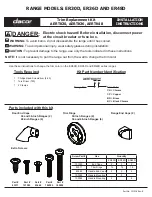
10
5. Cleaning Your Cooker
Isolate the electricity supply before carrying out any major
cleaning. Allow the cooker to cool.
n
n
NEVER use paint solvents, washing soda, caustic
cleaners, biological powders, bleach, chlorine based
bleach cleaners, coarse abrasives or salt.
n
n
DO NOT mix different cleaning products – they may
react together with hazardous results.
All parts of the cooker can be cleaned with hot soapy water
–
but take care that no surplus water seeps into the
appliance.
Remember to switch on the electricity supply before re-using
the cooker.
Hotplate Burners
The burner heads and caps can be removed for cleaning.
n
n
DO NOT put the burner heads in a dishwasher.
Make sure they are absolutely dry before replacing them.
•
Remove the pan supports, caps and heads of the
burners
•
Wipe and clean the hotplate with warm soapy water.
•
Wash the caps and heads and rinse them. Do not leave
them wet, immediately dry them with a kitchen towel.
•
After cleaning ensure they are re-assembled correctly
.
The Griddle
Always clean the griddle after use. Allow it to cool completely
before removing. Immerse the griddle plate in hot soapy
water. Use a soft cloth or, for stubborn stains, a nylon washing
up brush.
Note:
If the griddle is washed in a dishwasher then some
dishwasher residue may appear on the back. This is normal
and will not affect the performance of your griddle.
Grill
The grill pan can be easily removed for cleaning.
The grill pan and trivet should be washed in hot soapy water.
After grilling meats or any foods that soil, leave to soak for a
few minutes immediately after use. Stubborn particles may
be removed from the trivet using a nylon brush. Alternatively,
the grill pan can be washed in a dishwasher.
n
n
Before you remove any of the grill parts for cleaning,
make sure that they are cool, or use oven gloves.
n
n
DO NOT use any abrasive substances.
A
B
D
C
Fig.5-1
DocNo.042-0003 - Cleaning - CE 90 - GENERIC
A – Cap, B – Head, C – Electrode, D – Base










































